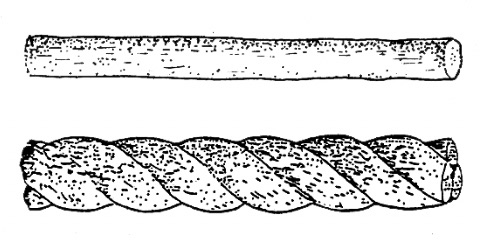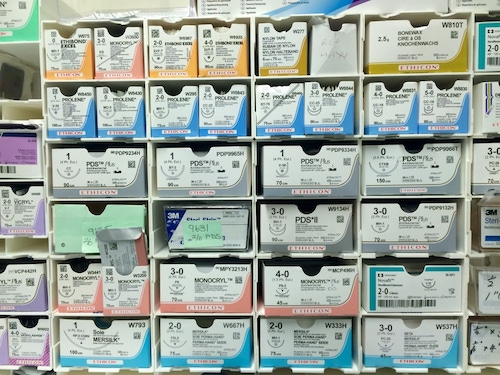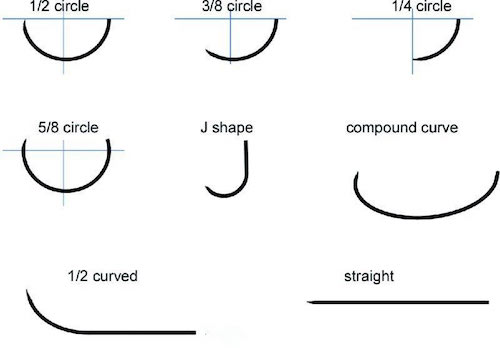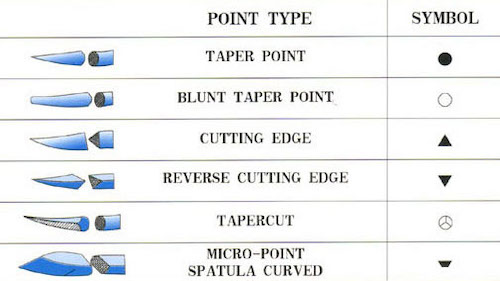Surgical Technology: Suture Properties
Suture Properties
US Pharmacopeia Sizes
- Larger “-0” number is smaller/more delicate
- 2-0 = ’00’, etc.
- 12-0: 0.001-0.009 mm
- 11-0: 0.010-0.019 mm
- 10-0: 0.020-0.029 mm
- 9-0: 0.030-0.039 mm
- 8-0: 0.040-0.049 mm
- 7-0: 0.050-0.069 mm
- 6-0: 0.070-0.099 mm
- 5-0: 0.1-0.149 mm
- 4-0: 0.15-0.19 mm
- 3-0: 0.2-0.249 mm
- 2-0: 0.30-0.339 mm
- 1-0: None
- 0: 0.35-0.399 mm
- 1: 0.4-0.49 mm
- 2: 0.5-0.59 mm
- 3 & 4: 0.6-0.69 mm
- 5: 0.7-0.79 mm
- 6: 0.8-0.89 mm
- 7: 0.9-0.99 mm
- 8: 1.0-1.099 mm
- 9: 1.1-1.19 mm
- 10: 1.2-1.29 mm
General Size Use
- ≥ 2-0: High Tension (Fascia)
- 3-0: Requiring Good Retention (Scalp, Torso, Hands)
- 4-0: Requiring Minimal Retention
- Most Common Size for Superficial Wounds
- ≤ 5-0: Delicate Areas Needing Little/No Retention (Cosmetic)
- Also Used in Vascular Cases
Braiding
- Monofilament (Single Strand)
- Less Reactive
- Less Tensile Strength
- Require More Ties (5-6) to Assure Knot Integrity
- Lower Risk of Infection
- Braided (Multiple Strands)
- Incites a Greater Inflammatory Response
- Increased Tensile Strength & Pliability
- Require Fewer Ties (3-4) to Assure Knot Integrity
- More Likely to Harbor Infection

Monofilament (Above) & Braided (Below)
Absorption
- Absorbable
- More Reactive – More Scarring
- Absorption Time Depends on Material
- Non-Absorbable
- Less Reactive – Less Scarring
- Time to Removal Depends on Location/Function
Barbed Suture
- Suture with Barbs Along the Length
- Barbs Made by Cutting into the Shaft of Smooth Suture
- Barbs Prevent Suture from Retracting Backwards
- Fixed at the End with Either a Loop or Anchor
- Brands:
- Quill
- V-Loc
- Stratafix Spiral
- Effects of Barbed Suture:
- No Knots Required
- Some Studies Show that Barbed Suture Better Maintains Tissue Tension & Integrity Over the Entire Closure (Debated)
- Distributes Force Over a Larger Contact Area & Reduces Tension on Tissue
- Despite a Reduced Tensile Strength (Due to Cutting into the Suture)
- Improved Efficiency – Reduced Closure Times & Easier Closure in a Laparoscopic Setting
- Effects on Inflammation & Wound Healing Not Yet Proven
- Negative Effects of Surgical Knots:
- Reduced Tensile Strength (Stretching & Thinning)
- Higher Volume & Density of Foreign Body Material – Increasing Inflammatory Reaction

Barbed Suture
Suture Material
Absorbable – Monofilament
- Chromic Catgut
- Material: Natural – Sheep/Cattle Mucosa (Not Cats)
- Absorption: 90 Days
- Strength Maintains for 1-2 Weeks
- Monocryl
- Material: Synthetic – Poliglecaprone
- Absorption: 90-120 Days
- 50% at 1 Week, 25% at 2 Weeks
- PDS
- Material: Synthetic – Polydioxanone
- Absorption: 180-210 Days
- 80% at 2 Weeks; 44% at 8 Weeks
Absorbable – Braided
- Vicryl
- Material: Synthetic – Polyglactin 910
- Absorption: 56-70 Days
- 75% at 2 Weeks, 50% at 3 Weeks, 25% at 4 Weeks
Non-Absorbable – Monofilament
- Prolene
- Material: Synthetic – Polypropylene
- Nylon
- Material: Synthetic – Nylon
Non-Absorbable – Braided
- Silk
- Material: Natural – Silk
- Ethibond
- Material: Synthetic – Polyester/Dacron

Suture Materials
Needles
Shape
- Straight
- 1/4 Circle
- 3/8 Circle
- 1/2 Circle
- 5/8 Circle
Point
- Tapered
- Round Body Tapered to a Point
- Separates Tissue Rather Than Cut
- Provides Smallest Diameter Hole
- Good for Soft Tissue Such as Bowel or Subcutaneous Tissue
- Cutting
- Triangular Body with a Cutting Edge on Inside
- Allows Smooth & Atraumatic Penetration
- Wound & Laceration Repair
- “Reverse Cutting” – Edge on Outside
Basic Needles
- Tapered
- Straight:
- ST (Straight Taper)
- 3/8 Circle:
- BV (Blood Vessel)
- C (Cardiovascular)
- TE (Three-Eighths)
- 1/2 Circle:
- SH (Small Half)
- MH (Medium Half)
- LH (Large Half)
- MO (Mayo)
- TP (Taper Point)
- CT (Circle Taper)
- 5/8 Circle:
- MF (Modified Ferguson)
- UR (Urology)
- Straight:
- Cutting
- Straight:
- SC (Straight Cutting)
- 3/8 Circle:
- CC (Calcified Coronary)
- PC (Precision Cosmetic)
- PS (Plastic Surgery)
- 1/2 Circle:
- V (Tapercut)
- Straight:
- Reverse Cutting
- 3/8 Circle:
- P (Plastic)
- FS (For Skin)
- FSL (For Skin Large)
- FSLX (For Skin Extra Large)
- 3/8 Circle:

Needle Shpaes

Needle Points